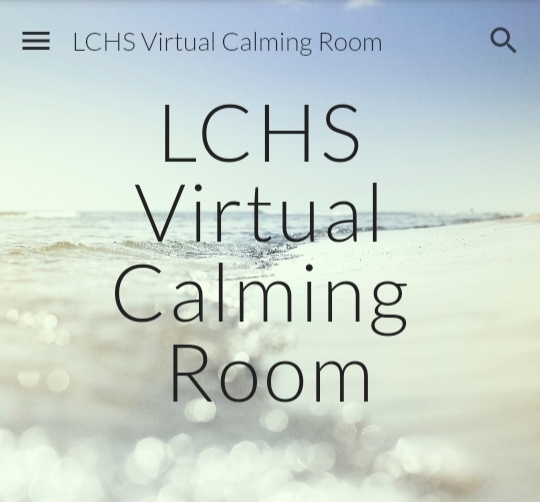This Virtual Calming Room is a place for students and families to find tools and strategies for managing emotions and feelings.
COPING WITH ANXIETY ----- LCHS Virtual Calming Room



"You can't wait until life isn't hard anymore before you decide to be happy. We are so much more than the bad things that happen to us." - Jane Kristen Marczewski "Nightbirde"
.
Main Reasons for ANXIETY
ANXIETY knows no boundaries. It is part of the Human experience but it is different for everyone. What is stressful for 1 person is not for the next What people freak out about most is not the presence of the adverse stimulus, but the ability to feel in control of the stimulus. The more OUT of control you feel… the more stressful you perceive the stimulus. The more IN control you feel… you may not perceive the stimulus as stressful at all.
CORE FEARS lead to feelings of LOSS OF CONTROL and/or trying to live up to some set of EXPECTATIONS. These CORE FEARS are : Inadequacy – Failure – Rejection – Abandonment – Judgment
Your feelings of anxiety are actually just temporary. If you steady your breathing and do things to help you stay in place, while shifting your mind on to something else, the feelings will pass and you will learn how to gain back control - which will lower your stress and anxiety. LIVE IN THE MOMENT - It is the only place you will find some sense of control.
.
A PATTERN OF THESE FOLLOWING SYMPTOMS SHOULD RAISE RED FLAGS
Attendance problems
Clinginess/separation anxiety
Panic attacks
Academic problems/decline in schoolwork
Frequent urination
Frequent crying
Difficulty concentrating/staying focused
Blushing/sweating
Feeling weak/tired
Excessive worrying
Health problems such as headaches or an upset stomach
Avoidance of people/situations
Sleeping problems
Lots of “what ifs?”
.
Learn how to fight through it
Are you struggling with STRESS, ANXIETY and/or DEPRESSION and wonder why you are feeling this way...
More importantly - What do you do about it?
.
Read some Excerpts from - The Stress Survival Guide for Teens – CBT Skills to Worry Less, Develop Grit & Live Your Best Life. by Jeffery Bernstein, PhD (2019)
Ways To Get More Sleep To Help Reduce Your Anxiety
.
Behavioral Treatment for Kids with Anxiety - Learn to handle the bully in the brain.
.
The Best Therapy to help Young People Face their Fears
.
12 Tips for Raising Confident Kids - How to build self worth in children and help them feel they can handle what comes their way.
.

The most beneficial thing for an anxious student is to understand WHY they are anxious.
Not just the surface why, but the deep, underlying reason why they are so anxious.
One way to help find the real underlying reason is by trying "THE 5 WHYS" 1st - ask “Why are you experiencing anxiety?” 2nd – use the answer to pose another why question and then Repeat this 5 times – until you get to the real reason
FOR EXAMPLE -
1 - Question - Why are you anxious about the test? Answer - Because I must get good grades, and tests count for 80% of my final grade.
2- Question - Why is it important to get good grades? Answer - I want to have happy parents.
3 - Question - Why is it important to have happy parents? Answer - It makes me feel good when they approve of me.
4 - Question - Why do you want your parents to approve of you? Answer - I want to achieve what my parents achieved, I want to have the kind of life they have.
5 - Question - Why do you want to have the kind of life your parents achieved? Answer - Because I don't want to be the odd man out.
The deep underlying reason is because the student wants to fit in with their family.
.
Build a GROUND GAME
GROUNDING is how you fight back against Anxiety by staying in the moment until the anxious feelings pass. Grounding will help distract your mind away from the anxiety feelings and keep you grounded in the present moment where you actually have control. We have to train hard at creating a good GROUND GAME. Just like in MMA (Mixed Martial Arts) fighting – GROUND FIGHTING is the hardest part of the fight. It is brutal, but it is where the fight is won. GROUNDING is the hardest part of fighting anxiety, but it too is where the battle is won.

GO-TO LIST of Techniques
Students can use these techniques during class without drawing, attention to themselves. These can also be used by teachers with the entire class – like at the beginning of the day, during transition times, or before tests. These coping techniques can help students internalize the importance of lifelong stress management. There is no quick easy fix for anxiety, but there is great success in learning to manage the stress.
.
Common exercises include:
GET ENOUGH SLEEP - Feeling tired can lower your ability to manage stress because it makes it harder for you to think straight. Getting enough sleep and rest increases your energy level, improves your memory, increases your ability to absorb new information and helps your body restore itself. (Turn your cell phone off or charge it over night in another room out of reach)
.
CREATE A LIST OF THINGS YOU ARE GRATEFUL FOR - (and refer to this list every time anxiety strikes) - Research shows that people who make an effort to be grateful are less stressed, sleep better and experience fewer health problems. Taking small moments every day to be grateful can go a long way in improving your mood and overall well-being.
.
.
PRACTICE MINDFULNESS - Mindfulness is simply making the effort to notice things that you wouldn't normally pay attention to. It means being aware of the sights, sounds, smells, and textures around you. Clear your mind, take several deep breaths, and focus on your environment. Focus on what you see, hear, smell and feel.
The Art and Science of Mindfulness
Here are a couple of MINDFULNESS TECHNIQUES
5-4-3-2-1 SENSES TECHNIQUE - Identify 5 things you can see, 4 things you can feel, 3 things you can hear, 2 things you can smell, 1 thing you can taste.
COUNTING - How many things you can see around the room in different shades of the same particular color. COUNTING - backwards by 7, starting at 100
PROGRESSIVE MUSCLE RELAXATION - Practice the relaxation of one muscle group at a time to release tension. Relax the muscle groups one at a time starting with the lower extremities (toes and feet) and moving up through your body (lower legs, upper legs, buttocks, stomach, lower back, chest, upper back, shoulders, upper arms, lower arms and hands) and then through your neck, face and out the top of your head.
.
.
MEDITATION is the act of tuning out the world and tuning in to your mind and body. Meditating can help you feel calm, centered, and grounded.
Here are a couple of Meditation techniques.
PRAYER - If you have faith and a belief in a God that loves you, Prayer and the belief that you are not alone is one of the most powerful tools that you can have.
DEEP BREATHING - To slow heart rate, lower blood pressure and increase oxygen intake, which all have a calming effect. Common exercise - BELLY BREATHING – inhale for the count of 4, hold for the count of 4, exhale for the count of 4 - Repeat for as long as needed.
IMAGERY - Go to your "Happy Place". Create a detailed mental image of a safe and peaceful place. Imagine being in that space. This will direct attention away from what is stressing you and toward an alternative focus.
.
.
Do whatever fills your cup
POSITIVE SELF-TALK AND AFFIRMATIONS - Use positive self-talk to challenge self-sabotaging and negative thoughts. Practice through journal writing, negative thought stopping, or snapping a rubber and during negative thoughts. Select affirmations statements that speak to you. Repeat affirmations and practice believing them. This will start to make positive changes.
JOURNALING - This helps clarify thoughts and feelings, thereby gaining valuable self-knowledge. This can process anxiety by fully exploring and releasing the emotions that are involved. This engages both sides of the brain and allows the experience to become fully integrated within one’s mind.
REACH OUT TO A FRIEND - “No man is an island” – John Donne. We don’t feel good or fare well when we feel alone and isolated. This is especially true when we feel stressed out. Seek emotional support from others. Being alone in your stress can leave you bottled up with it. But venting to others can help you avoid emotionally exploding or imploding. Try texting or talking to a friend, family member or someone you trust. Giving a pet some affection can provide a sense of companionship and safe, nonjudgmental support too.
GET YOUR BODY MOVING - Go Outside. Doing some exercise will increase the flow and/or effect of your brain’s feel-good neurotransmitters, called endorphins. Moving and focusing on your body gets you tuned into the present moment, which helps you break away from worries about the past or the future. The more you move the less stressed you’ll probably feel.
CRACK YOURSELF UP - Laughing gives you a release from stress by quickly changing your perspective from being in crisis to feeling a fresh new attitude. It also strengthens your immune system. - Watch an online clip of babies laughing -Watch videos of pets doing amusing tricks -reflect on fun times with family or friends -Listen to your favorite comedian
DRAW A MANDALA - Mandalas are any type of circular design drawn from the middle and progressively moving outward. (google it) Throughout history and across religions, mandalas have been seen as very soothing and calming.
“YOU ARE WHAT YOU EAT” - Eating healthy, nourishing meals, or having a warm cup of herbal tea or bowl of good soup when you’re feeling stressed, will set the stage to calm you down. Sugary or caffeine-loaded beverages will likely leave you wound up and maybe even agitated.
.
Other things you can include are
LISTEN TO SOFT MUSIC,
READ A BOOK,
TAKE A WALK,
PLAY WITH A PET,
TAKE A BATH,
WATCH TV

This Virtual Calming Room is a place for students and families to find tools and strategies for managing emotions and feelings.
